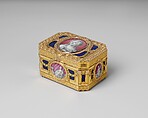Snuffbox
Possibly by Pierre-François-Mathis de Beaulieu
Not on view
An oval portrait of Catherine the Great of Russia on the cover of this box is the most prominent feature of its decoration. Catherine ruled Russia as empress from 1762 until her death in 1796, and the small enamel portrait depicts her early in her reign. The underside of the box is decorated with an image of the empress crowned by fame, while the small enamel medallions on the sides depict the four cardinal virtues: fortitude, justice, prudence, and temperance. The decoration thus serves to extol the virtues and qualities of the new empress, who came to power by deposing her husband, Peter III.
The chased motifs are in the fullblown Neoclassical style, and four colors of gold have been employed to enhance their richness. Gold could be colored by adding small amounts of other metals: copper gives gold a warm pinkish hue, and silver creates a slightly greenish tone. Acting as a visual foil to the various colors of gold is the translucent blue enamel, through which the decorative pattern of the gold beneath is visible.
Richly decorated boxes with a portrait of a reigning monarch were frequently given as diplomatic gifts or to reward a special service or favor to the court. These gifts had the dual advantage of conveying great prestige upon the recipient while also being of significant monetary value. It was common practice for monarchs to present gold boxes bearing a portrait of themselves to visiting ambassadors or ministers; the Duke of Manchester, acting as British envoy, received a box from Louis XVI valued at slightly more than 31,000 livres, at a time when a successful doctor in France might earn 10,000 livres annually.
This box is attributed to the goldsmith Pierre-François-Mathis de Beaulieu, although it bears the mark of Jean George as well as the inscription “George à Paris.” The box’s design is very similar to that of a slightly later example marked by Beaulieu, who served as an apprentice to George. As Beaulieu did not become a master until 1768, he would have had to use George’s mark when this box was made, in 1764–65.
Due to rights restrictions, this image cannot be enlarged, viewed at full screen, or downloaded.

